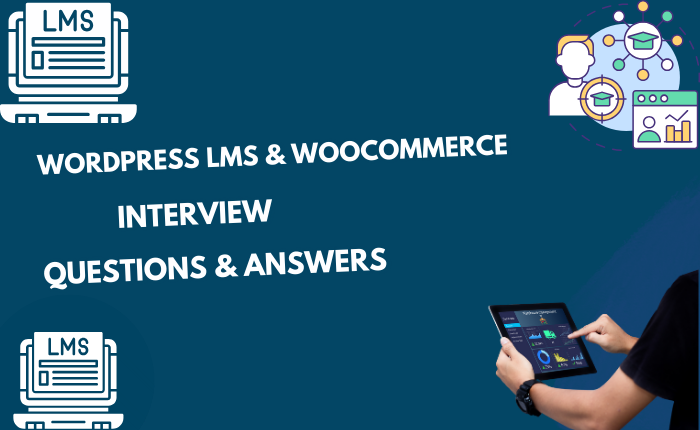WordPress LMS (Learning Management System) & WooCommerce Interview Questions
WordPress LMS (Learning Management System) & WooCommerce Interview Questions
1. What Is an LMS in WordPress?
An LMS (Learning Management System) in WordPress is a plugin or platform used to create and manage online courses.
2. What Are the Most Popular LMS Plugins for WordPress?
- LearnDash
- LifterLMS
- Tutor LMS
3. How Do You Install and Set Up an LMS on WordPress?
- Install an LMS plugin (e.g., LearnDash).
- Configure course settings.
- Add lessons, quizzes, and assignments.
- Set up user registration and payment options.
4. What Are the Key Features of a WordPress LMS?
- Course creation & management
- Student progress tracking
- Quizzes & certifications
- Integration with WooCommerce for payments
5. How Can You Monetize an LMS Website?
- Selling courses via WooCommerce
- Subscription-based access
- Membership models (e.g., MemberPress)
- Affiliate marketing
6. How Do You Customize the Design of a WordPress LMS?
- Using WordPress page builders (Elementor, Divi).
- Customizing CSS & themes.
- Modifying LMS plugin templates.
7. How Can You Restrict Course Access to Paid Users?
- Using WooCommerce Memberships.
- Configuring LearnDash access rules.
- Implementing LMS-specific memberships.
8. How Do You Optimize an LMS Website for SEO?
- Add structured data (Schema Markup).
- Improve page speed & mobile responsiveness.
- Optimize course descriptions & URLs.
9. How Do You Integrate an LMS with WooCommerce?
- Install WooCommerce.
- Connect courses as WooCommerce products.
- Configure payment gateways (Stripe, PayPal).
10. How Do You Track Student Progress in WordPress LMS?
- Use LMS analytics dashboards.
- Enable progress reports & certificates.
- Integrate with Google Analytics for user tracking.
11. What Is WooCommerce?
WooCommerce is a WordPress plugin that adds e-commerce functionality, allowing users to sell products online.
12. What Are the Key Features of WooCommerce?
- Product management (simple & variable products).
- Payment gateway integration (PayPal, Stripe).
- Order & inventory management.
13. How Do You Install and Set Up WooCommerce?
- Install the WooCommerce plugin.
- Configure store settings (currency, taxes, shipping).
- Add products & categories
14. What Are the Best WooCommerce Payment Gateways?
- PayPal
- Stripe
- Razorpay
15. What Is the Difference Between Simple and Variable Products in WooCommerce?
- Simple Product – A single product with no variations.
- Variable Product – A product with multiple variations (e.g., size, color).
16. How Do You Improve WooCommerce Website Speed?
- Use caching plugins (WP Rocket).
- Optimize images with WebP.
- Enable CDN (Cloudflare, BunnyCDN).
17. How Do You Add Custom Shipping Methods in WooCommerce?
- Configure Flat Rate, Free Shipping, Local Pickup.
- Use WooCommerce Shipping Plugins.
- Integrate with Courier APIs (Shiprocket, DHL, FedEx).
18. How Do You Secure a WooCommerce Store?
- Install SSL certificate.
- Use two-factor authentication (2FA).
- Implement firewall plugins (Wordfence, Sucuri).
19. How Do You Set Up an Affiliate System in WooCommerce?
- Use AffiliateWP plugin.
- Set commission rates & payout methods.
- Monitor affiliate clicks & conversions.
20. How Do You Recover Abandoned Carts in WooCommerce?
- Send automated email reminders.
- Offer discounts & coupons for abandoned carts.
- Use cart abandonment plugins (WooCommerce Recover Abandoned Cart).
21. What Is the Difference Between WooCommerce and Shopify?
- WooCommerce – Open-source, self-hosted, full control.
- Shopify – Hosted platform, easier but less customizable.
22. How Can You Improve WooCommerce Checkout Page?
- Use One-Page Checkout plugins (WooCommerce Fast Cart).
- Enable Guest Checkout to reduce friction.
23. How Do You Add Custom Fields to a WooCommerce Product Page?
- Use Advanced Custom Fields (ACF) plugin.
- Edit WooCommerce templates via functions.php.
24. How Can You Track Sales Performance in WooCommerce?
- Use WooCommerce Reports.
- Integrate Google Analytics & Facebook Pixel.
25. How Do You Set Up a Multi-Vendor Marketplace in WooCommerce?
- Use Dokan, WC Vendors, or MultiVendorX plugins.
- Allow vendors to create their stores & manage orders.








